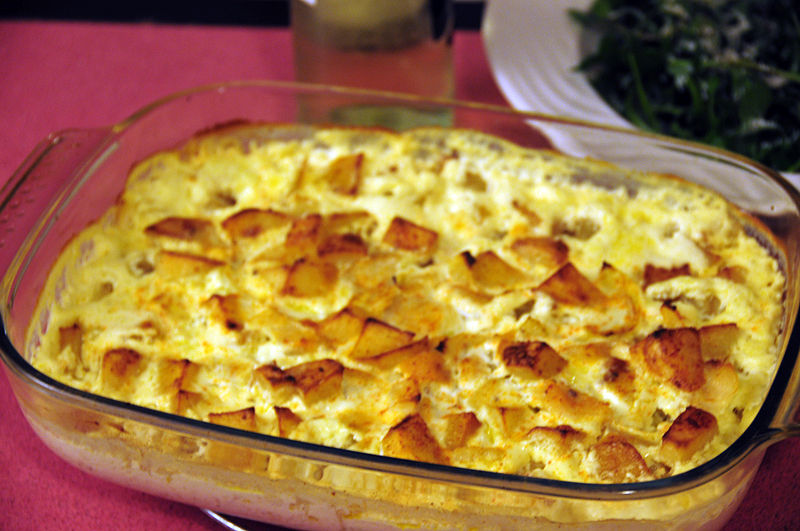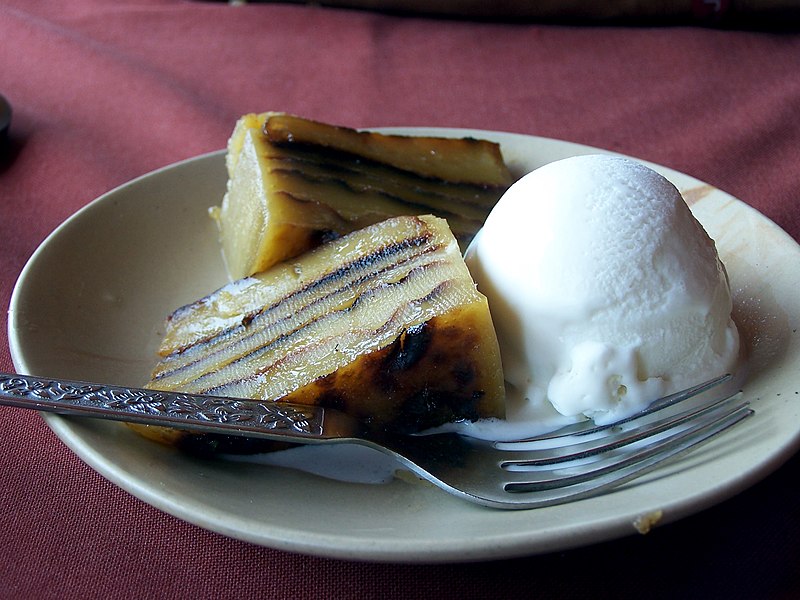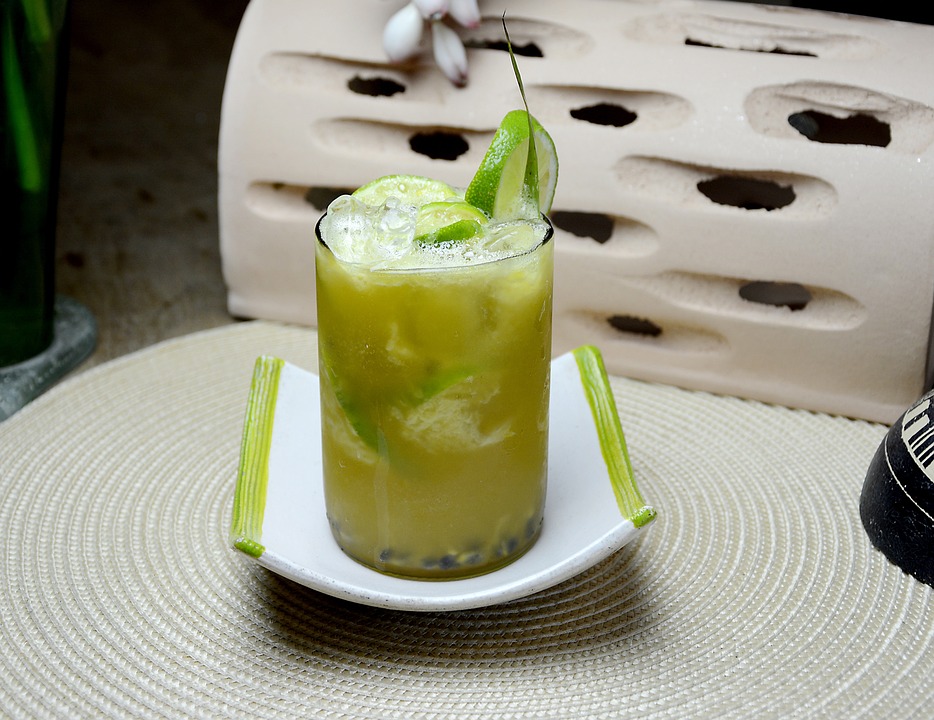
Eating is a universal experience. It’s an essential need and also a delight. The ingredients and cooking methods of the foods we eat can reveal our preferences, our dislikes, our cultural background, and our environment.
Now, consider the mouth. It’s the path of the word and also the gateway to discovering numerous flavors. The same tool that articulates intellectual ideas about the world also takes sensual information from it—what a poetic exchange.
Indeed, truths aren’t contained solely within ideas and debate. New flavors and foods can talk and reveal so much about different countries and people.
Traditional Portuguese food may not be as internationally popular as the French or Italian cuisines, but it’s incredibly rich and diverse. People from Europe, America, Asia, and Africa are bonded by this colorful gastronomic heritage.
In this article, you’ll discover some of the most significant Portuguese foods as well as a few Portuguese food recipes to try at home. Let’s dive into it—a bite at a time.
 Table of Contents
Table of Contents
- A Glimpse of the Lusophone Heritage
- Must-Try Dishes in Portuguese Restaurants
- “Portuguese” Food Elsewhere
- Unique Portuguese Foods
- Portuguese Food-Related Vocabulary
- Two Simple Authentic Portuguese Food Recipes
- Conclusion
1. A Glimpse of the Lusophone Heritage

Buckle up: codfish and cream and more of the most amazing Portuguese foods wait for you!
Well before the globalization phenomenon, Portugal delved into a journey of international discovery and commercial experience in the late fifteenth century.
The Portuguese were the first to go through some dangerous, landmark maritime routes and access such territories as: Brazil, East Timor, Guinea-Bissau, Mozambique, India, Macau (China), Japan, Angola, Cape Verde, Qatar, Oman…
It was an imperialistic enterprise with both positive and catastrophic consequences. This exchange resulted in the permanence of certain cultural elements in some of these countries, which are still reflected in their gastronomy and language. This can certainly be seen in their adoption of ingredients and food traditions.
Contemporary Portuguese chef Luis Simões states that traditional Portuguese dishes share more similarities with dishes in other Lusophone countries than with those of neighboring European countries, for instance.
2. Must-Try Dishes in Portuguese Restaurants
Due to this early globalized exchange, some of the best Portuguese food available doesn’t come from Portugal! The following delicacies take part in a parade of delights that are a tour-de-force for every gourmand interested in authentic Portuguese cuisine.
A- Bacalhau com natas (“Cod fish with cream”)
Codfish can be defined as the backbone of Portugal’s cuisine. More than a typical Portuguese food, it’s a symbol of the nation’s past maritime triumphs and of its present life as a coastal country. Cream, though it can be prepared in many fashions, is another essential Portuguese ingredient and is often present in desserts.
Bacalhau com natas is a very popular Portuguese food, available at nearly every restaurant in Portugal.
Ingredients: codfish, potatoes, cream, béchamel sauce, onions, laurel, nutmeg, garlic, olive oil
It’s delicious because: The combination of fish and cream is undeniably odd. That’s the beauty of this dish: the codfish serves as more of a regular meat than a fish, so mixing it with cream works so well!

Feijoada is the perfect dish to enjoy with a happy squad!
B- Feijoada
Feijoada is one of the most famous Portuguese food recipes from Brazil.
Black beans are a product of South American land. This dish was conceived when Europeans (most notably the Portuguese) adopted this ingredient in pork meat stews in Brazil.
Sometimes, its creation is credited to the slaves, though there’s no full-proof historic support for this assumption. Brazilian folklorist Câmara Cascudo said it was impossibe because it involved pork consumption when many of the enslaved African were of a Muslim background. However, the slaves were of varying religious backgrounds, and the question remains a topic of debate.
Ingredients: black beans, pork meat (various pieces), pork chop, collard, farofa, pork rind, oranges, laurels, chives, pepper, breaded banana
It’s delicious because: Both the texture and the taste of this dish are hard to parallel. Besides, the consumption of this dish often involves gathering with friends, drinking juice and caipirinha, and having fun—who would want to eat so much by themselves?
C- Chamuça (“Samosa”)
Chamuça dates back many centuries, and today it’s a prime example of Portuguese street food. The Portuguese discovered this incredible snack during their adventure in Goa, part of India. But its origins go even farther back in time, all the way to Ancient Persia. Chamuça is very popular nowadays in Mozambique, Portugal, and India.
This well-loved Portuguese snack is often filled with a mixture of meat, herbs, potatoes, and other vegetables.
Ingredients: flour (wheat), margarine, salt, vinegar, other ingredients for filling
It’s delicious because: It’s a type of fried pastel (“pastry”) that’s made with very fine dough. It’s delicious but not expensive—both necessary features of an ideal Portuguese street food.
D- Alheira
As this is one of the most authentic Portuguese foods, to speak of only one alheira recipe should be a crime. There are many variations of this sausage throughout Portugal, with the Mirandela, Vinhais, and Barroso-Montalegre types being the most popular.
Ingredients: meat (chicken and beef), garlic, bread, ham, pepper, salt, wine, and more
It’s delicious because: Alheiras recipes often include delicious Portuguese wine, and the varieties of sausage across Portugal each have their own unique taste. Since the country’s territory isn’t large, a culinary adventure to explore alheiras is an excellent expedition to promote!

Sweet, sweet bebinca… (Photo by Warren Noronha under CC BY 2.0)
E- Bebinca
Bebinca is one of the amazing Portuguese desserts of Timorese and Indian roots. It’s a moist, delicate, heavily spiced cake.
Ingredients: egg yolk, sugar, cardamom, coconut milk, flour (manioc or rice), butter
It’s delicious because: Try some slices of it with a scoop of vanilla ice cream and you’ll understand. It’ll make you forget about the wonders of fondant au chocolat (“chocolate fondant”) in under a minute.
3. “Portuguese” Food Elsewhere
Over time, traditional Portuguese food has found its way into many other countries. These overseas versions are far from being authentic. For example, native Portuguese may never have even heard of supposedly famous ‘Portguese’ dishes from another country. Also, the ingredients and cooking methods of a Portuguese dish may vary widely from one country to another.
The following are examples of “false” Portuguese food.
A- Feijoada
“False” version: Black beans are not very easy to find in some countries, nor are the spices used in the original dish. Not to mention how expensive pork meat can be… So why not improvise with other ingredients?
Why it sucks: If feijoada lacks pork meat, you end up with a thin broth. By using another type of bean, it’ll taste completely different. And if the spices are missing too, why bother preparing this dish? As an alternative, there’s canned feijoada for sale in some places—according to some myths, there’s a circle in Hell reserved for its producers.

Caipirinha: accept no imitations
B- Caipirinha
“False” version: There are many international twists on the original recipe of cachaça, lemon, and sugar. The most common involves replacing cachaça for vodka or sake. Others involve blending multiple exotic fruits.
Why it sucks: The most famous Brazilian cocktail is the target of many well-intentioned mixologists worldwide (including in Brazil). While its simplicity is the source of its beauty, people insist on delivering “gourmet,” “innovative” renditions of the classic. The world needs an organic apricot-and-sake caipirinha—just like it needs a 3D reshoot of a Chaplin picture featuring Vin Diesel.
C- Churrasco (“Barbecue”)
“False” version: The worst alternative versions of it involve vegetarian meat, meat of poor quality, and lots of sauce. Some ‘Brazilian steakhouses’ out there even sell crocodile meat—crocodiles aren’t even native Brazilian animals! Also, the proportion of the meat served is important: bovine meat is paramount, pork and poultry are auxiliary. Fish can also be a good surprise in some culinary circles.
Why it sucks: Brazilian churrasco involves pieces of meat, coarse salt, coal, fire, and sometimes side dishes. There’s no need for more—or at least call it something other than churrasco. To be fair, there are also many styles of barbecue worldwide. Argentina, Uruguay, the United States, and other countries have their own takes on the dish.
D- Codfish Dishes
“False” version: Codfish is a Portuguese classic which can be prepared in many different ways. But it’s an expensive ingredient in some places, so the cook’s solution is often to hide small pieces of codfish among lots of potato, eggs, and olive.
Why it sucks: Well, if you order a codfish dish, it’s preferable to have codfish in it!
4. Unique Portuguese Foods
Some of the best Portuguese food products can only be found in one or two Lusophone countries, yet they’re so popular that language learners should know about them. Check out these unique Portuguese food and drink options you need to try!
A- Fruits

Guaraná: the fruit’s appearance kind of resembles how you look before consuming it… (Photo by AnitaFortis under CC BY-SA 3.0)
Açaí (Brazil) – This is a little, energetic, dark berry from the Amazon that’s growingly popular among foreigners. They can be consumed in salty dishes with fish and shrimp, by itself as a fruit, or in an icy dessert.
Guaraná (Brazil) – Another highly energetic fruit from the Amazon, this is typically used as an ingredient for guarana soda pops. Because the guaraná seed contains around twice as much caffeine as a coffee bean, the guaraná powder is also used as a stimulant supplement and as an ingredient in energy drinks.
Caju (Brazil, Angola) – Otherwise known as cashew nuts, this nut is a famous fruit which should not be eaten raw. It contains a toxin that burns the skin, which is why it’s usually sold after being processed. What many people don’t know is that the orange part that hangs from the nut is also edible. It can be consumed fresh, in desserts, or as a juice. Tasty!
Banana da Madeira (Portugal, Cape Verde) – This banana from Madeira Island is very sweet and relatively small. It’s a good ingredient to add something different to dessert recipes!
B- Drinks
Ginja (Portugal) – Also known as ginjinha, this is a liquor made of sour cherries. A very sweet and popular drink for shots, ginja is from Óbidos and Alcobaça.
Bibidi (Angola, cashew cachaça) – If you were surprised about the existence of the cashew fruit, you might be interested in tasting this liquor. It’s hard to find a bottle outside of Angola, though.
- → Want more? Then see our vocabulary list of 20 Drinks to Quench Your Thirst!
5. Portuguese Food-Related Vocabulary
Before you can have a taste of traditional Portuguese food, you have to learn how to order it. Check out the most important expressions for talking about food in Portuguese:
A- Describing Food and Hunger
- Este é o meu prato preferido! (“This is my favorite dish!”)
- Estou faminto/faminta. (“I am starving.”)
- Perdi o apetite. (“I’ve lost my appetite.”)
- Essa sopa está muito gostosa! (“This soup tastes delicious!”)
- A feijoada ainda está quente demais. (“The feijoada is still too hot.”)
B- Ordering Food
- Vocês servem comida sem glúten? (“Do you serve gluten-free food?”)
- Você prefere a carne mal passada, ao ponto ou bem passada? (“Do you prefer your meat rare, medium, or well done?”)
- Me desculpe, eu não como cebola. (“I’m sorry, but I don’t eat onion.”)
- Eu tenho alergia a frutos do mar. (“I’m allergic to seafood.”)
- Eu tenho intolerância a lactose. (“I’m lactose-intolerant.”)
- Eu sou vegetariano(a)/vegano(a). (“I am a vegetarian/vegan.”)
You can learn more phrases for talking about what you don’t eat in our lesson titled Being Vegetarian in Portugal.
C- Cooking Food
- Primeiro, você soca o alho. (“First, you crush the garlic.”)
- Depois, você refoga alho e cebola no azeite. (“Then, you sauté garlic and onion in olive oil.”)
- Por fim, cozinhe a carne em fogo médio. (“Finally, boil the meat on medium heat.”)
- Deixe os ingredientes aquecendo em banho-maria. (“Let the ingredients heat in water bath.”)
- Bata as claras em neve. (“Beat the egg whites until stiff.”)
- Desenforme o bolo e deixe-o descansar. (“Unmold the cake and let it cool.”)
For more useful vocabulary, see our list of Essential Vocabulary About Cooking!
6. Two Simple Authentic Portuguese Food Recipes
Anxious to finally sink your teeth into some good Portuguese food? Then wait no longer! In this section, we’ll teach you how to cook Portuguese food at home! These two recipes are so simple that anyone can make them.
1)Caldo verde (“Green broth”)

Caldo verde: Portuguese comfort food at its best (Photo by Therese C under CC BY 2.0)
Ingredients:
- 3 potatoes, cut into cubes
- 1 liter vegetable broth
- 1 onion, cut into cubes
- 4 tablespoons olive oil
- 1 packet thin-sliced collard
- 1 Portuguese sausage (paio type)
- 1 clove of garlic
- salt
- black pepper
How to prepare (4 servings):
1. Pour some olive oil into a pot and sauté the onion until it softens. Add in the sausage and half of the collard and let it sauté for 2 minutes.
2. Pour the potatoes, the broth, and the sliced garlic clove into the pot. Stir and wait until the potatoes soften.
3. Remove the slices of sausage and let them sit.
4. Pour the solid ingredients into a blender until the mixture turns into a puree, and then mix the result with the rest of the soup.
5. Put the mix back in the pot, and add some salt, pepper, and the collard and sausage. Mix it up and let it heat.
6. Serve the broth. You can add some olive oil and eat it with bread.
2)Arroz doce (“Sweet rice”)

Time for dessert! (Photo by unknown artist under CC BY-SA 3.0)
Ingredients:
- 2 cups of rice
- 10 cups of water
- 1 liter of milk
- 1 can of condensed milk
- 4-6 tablespoons of sugar
- some cinnamon
How to prepare (10 servings):
1. Cook the rice in the water until it softens.
2. Add the milk and mix it up.
3. Let it boil for 5 minutes.
4. Add in the condensed milk and the sugar, and keep mixing.
5. Let the mix reduce and thicken.
6. Serve with powdered cinnamon on top.
Psst…you can learn more about Brazilian Sweets and Desserts in our Culture Class lesson. 😉
7. Conclusion
Now that you’ve learned the basics of Portuguese food, why stop there? Portuguese vocabulary and the cultural aspects of Lusophone countries are a rich stream of ever-expanding learning opportunities—and you can get a taste of this at PortuguesePod101.com!
All of our lessons and exercises are thoroughly organized to ensure a fun and effective learning experience. Have one bit of it and you’ll want to stay for dessert!
Let us know in the comments which Portuguese food you’re most excited to try, and why! We look forward to hearing from you.










